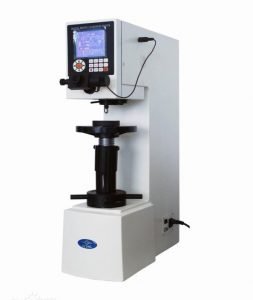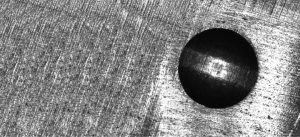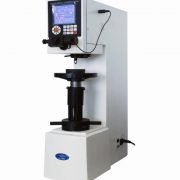Introduction to Brinell Hardness
Brinell hardness is a standard that indicates the hardness of a material. Measured by Brinell hardness tester. It was first proposed by the Swede J.A. Brinell, thus called Brinell hardness.
Press a hardened steel ball with a diameter of D into the surface of the metal material to be tested with a certain load P. And then remove the load after holding it for a period of time. The ratio of the load P to the surface area F of the indentation is the Brinell hardness value, denoted as HB.
Introduction to brinell hardness
Brinell hardness (HB) is generally used when the material is soft. For example, non-ferrous metals, steel before heat treatment or after annealing.
HB refers to pressing a hardened steel ball or cemented carbide ball of a certain diameter into the surface of the metal to be tested with a certain test load. Keep it for a specified time, then unload, and measure the diameter of the indentation on the tested surface.

Brinell Hardness Tester
Hardness range
The Brinell hardness range is 8~650HBW.
Features
Generally speaking, the smaller the HB value, the softer the material, and the larger the indentation diameter. Conversely, the larger the HB value, the harder the material, and the smaller the indentation diameter.
The advantage of HB measurement is that it has high measurement accuracy, large indentation area. Thus can reflect the average hardness of the material in a larger range. The measured hardness value is also more accurate, and the data is repeatable.
Symbol
The symbol of Brinell hardness is represented by HBS or HBW.
HBS means that the indenter is a hardened steel ball, which is used to determine materials with a Brinell hardness value below 450, such as mild steel, gray cast iron, and non-ferrous metals.
HBW indicates that the indenter is a cemented carbide and is used to determine materials with a Brinell hardness value below 650.

Brinell Hardness Testing Insight
How to express Brinell hardness
The number before HBS or HBW is the hardness value, and the following numbers are used to indicate the test conditions in sequence:
①The diameter of the sphere of the indenter;
②Test load;
③The time that the test load is maintained (10~15s are not marked).
For example, 170HBS10/1000/30 means that a steel ball with a diameter of 10mm is used. Under the test load of 9807 N (1000 kgf), the measured Brinell hardness value is 170 when kept for 30s.
530HBW5/750 means using a 5 mm diameter cemented carbide ball, under the test load of 7355N (750kgf), the measured Brinell hardness value is 530 when it is maintained for 10-15s.
Application
The HB measurement method is suitable for cast iron, non-ferrous alloys, various annealed and tempered steels. It is not suitable to measure samples or workpieces that are too hard, too small, too thin, and whose surface is not allowed to have large indentations.
Yide casting is an experienced casting supplier, specialized in casting iron for 28years, can manufacture the casting iron parts according to your drawing file and requirement. If you are looking for a casting manufacturer, please feel free to contact us for more details, and you are welcome to visit our factory for more details.




Leave a Reply
Want to join the discussion?Feel free to contribute!